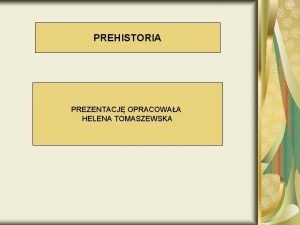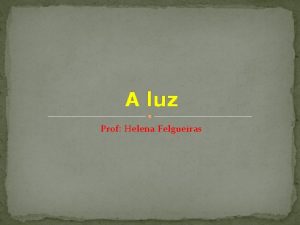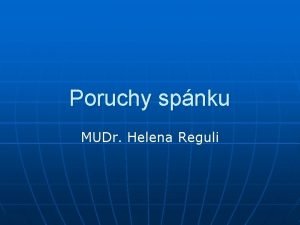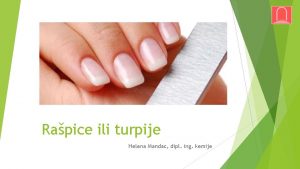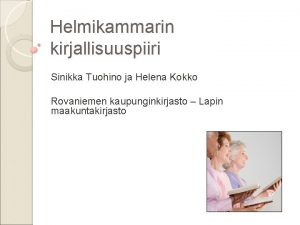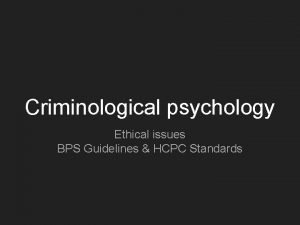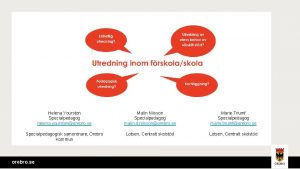Criminological Psychology Charlton et al 2000 St Helena














- Slides: 14

Criminological Psychology Charlton et al 2000: St. Helena study

In the exam, you may be asked to describe and evaluate a study other than Loftus & Palmer’s Therefore, the Learning Outcomes for this session are that you will be able to: describe Charlton et al’s study (APRC) evaluate* the study (GRAVE) *make at least 2 positive and 2 negative evaluation points This relates to the AC in the spec, section 4 a, page 44

The Island of St. Helena is … One of the most isolated islands in the South Atlantic Ocean 2000 km from mainland Africa Only accessible by boat A small, close-knit community where everyone knows each other And has approx. 5000 inhabitants (1000 children of school age)

The study … Background - before March 1995, the island of St Helena had no access to television Charlton and his colleagues began their study in 1993 (2 years before television was introduced to the island) This was a natural (field) experiment, where the independent variable (TV) was happening naturally and not manipulated by the experimenter

The study … Aim: to investigate the effects of television on children’s behaviour, particularly on pro-social and antisocial behaviour

Pro-social behaviour is. . . . that which is intended to help others; it is characterized by a concern about the rights, feelings and welfare of other people Anti-social behaviour is. . . . behaviour which lacks consideration for others and may cause damage to the society, whether intentionally or through negligence

The study … Procedure: This was a cross-sectional design Researchers studied the playground behaviour of a random selection of schoolchildren (aged 3 -8 years), from 2 of the island’s largest schools Video recorders were set up in the playgrounds of the schools four months prior to the introduction of television and once again five years later

The study … Procedure: The children’s free play during break times was recorded for a two-week period each time and researchers compared the findings to establish whether or not behaviour had changed as a result of television being introduced Playground behaviours were categorised as such: Pro-social – pro-social gestures/verbal comments; sharing, turn-taking and helping; displaying affection or consoling others; holding hands/arm-in-arm Anti-social – anti-social gestures/verbal comments; kicking, hitting, punching; seizing/damaging property; non-compliant holding/forcing

The study … Procedure: Independent researchers in the UK watched the video footage and tallied the number of times children/groups of children displayed these behaviours Two researchers watched the same video footage alone as many times as necessary and only agreed tallied behaviours were recorded in the results

The study … Results: Of 64 comparisons made between the behaviour of children at the start and the end of the study, only nine were statistically significant: Two showed decreases in anti-social behaviour amongst boys Five showed increases in pro-social behaviour Two showed decreases in pro-social behaviour in boys

The study … Results: Boys tended to display less hitting and pushing after television was introduced, but were also less willing to help and show affection Both boys and girls showed significant increases in prosocial behaviour overall

The study … Conclusion. . . The introduction of television had no negative effect on children’s behaviour – in fact, quite the reverse! This finding shows longer-term effects and challenges the findings of most of the laboratory research into the effects of TV on children’s behaviour

Evaluation. . . Strengths: The findings are high in ecological validity because the children were observed in their natural environment; video cameras were hidden, so the children would have played naturally Use of video recordings prevented researcher bias and observer fatigue; because the recordings were watched by two different researchers separately and agreed behaviours only were recorded, there was inter-rater reliability (this eliminates subjective interpretation of the behaviours)

Evaluation. . . Limitations: The children’s viewing habits (types of programmes, hours of watching, etc. ) were not analysed*, so it is difficult to assign any behaviour changes to the effects of watching TV The culture of parental control and close supervision on the island may have inhibited the children from imitating behaviour seen on the screen * Later research revealed that the types of programmes watched were different than those shown on the mainland; children’s programmes containing aggression were not broadcast









